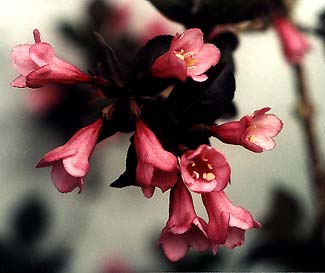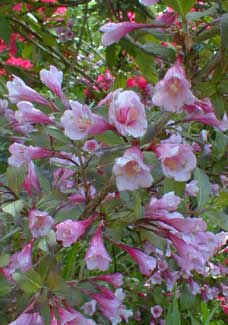
'Java Red'
Weigela
"I know you say that there's no-one for you
but here is one;
all flowers in time bend towards the sun."
-Jeff Buckley
(1966-1997)
(1966-1997)
For a long time I didn't know how to pronunce Weigela & had given ours the pet-name Wiggly. It should be prounced wy-GEE-la, a woody relative of honeysuckles.
Weigela florida 'Java Red' has alternatively been sold with the names 'Rhoni,' 'Purpurea,' & most commonly 'Foliis Purpureis,' these names alluding to the purple leaves of this cultivar.
Weigalas can frankly look pretty glum much of the time when sold small & young, whereas large ones can get all rangy. But when they are some years old, they begin to have very gnarly limbs that are quite beautiful even when the leaves are gone in winter, & this is even more true of 'Java Red,' a recipient of the Award of Garden Merit. Of course when in flower, even young weigelas are bound to be pleasing, but they are slow-growing shrubs that take ten years before they really look ruggedly mature.
 The species name florida does not allude to the Southern state, but to the shrub's floweriness. Weigalas are originally from China & Korea. Here in the Northwest 'Java Red' blooms by about mid-May, though in 2005 it was in full bloom before the end of April.
The species name florida does not allude to the Southern state, but to the shrub's floweriness. Weigalas are originally from China & Korea. Here in the Northwest 'Java Red' blooms by about mid-May, though in 2005 it was in full bloom before the end of April.The buds begin a deep red & open into funnel-shaped lavender-red funnels. When the flowers of 'Java Red' are spent, the purplish cast of the young leaves & stems lasts the entirety of spring, & only slowly fades to mat-green as summer progresses, providing the shrub a lingering color value.
There are dozens of weigala cultivars. With a recent explosion of new varieties, some of the earliest cultivars are now being called "Old Fashioned Weigela." Java Red is one of the oldest. It is a dwarf, only rarely exceeding four feet of height, making it at its biggest half the size of the majority of weigelas. Due to its compact habit it is one of the least prone to ranginess when left unpruned, though some degree of ranginess seems inescapable even with a compact dwarf, demanding some pruning once every three years, as opposed to the need for annual pruning for full-sized weigalas.
If I'd made the selection I might've gone for another variety altogether, one that gets really big, but it'd be a hard call since large varieties need more training & pruning to look their best, besides which, our gardens are small. But it wasn't my choice to make as this was planted by people who lived here years before us.
I might or might not have been able to figure out the exact cultivar without help, but fortunately I didn't have to just guess; when cleaning out some Vinca minor that had gone aggressively wild, I found brittle old tags for many plants, most of which had killed off by the vinca, but among the tags was the one for 'Java Red.'
Since the past owners of this place did plant the weigala rather too close to barberries, it's just as well they chose a dwarf weigala, or that whole row of shrubs would've been overcrowded some time ago, especially as weigalas tend to get wider than they do tall. As it stood, I over time moved three of four red barberries & one of two golden barberries, because the former gardeners of this residence failed to consider how big some of those bushes would get, & planted them with scant two foot spaces between. Even with so many shrubs moved elsewhere, there was still insufficient room for the weigela.
The Java Red had gotten a bit taller than the assumed maximum, being about five feet high if one counted one vagrant branch that reached above the main plant. Due to its age it has wondrously gnarly bark. Because it had no room to spread out, it had remained quite narrow & upright, attempting to adapt to the narrow location between larger overbearing shrubs. A few side-limbs had wound through the neighboring shrubs to a considerable distance. Granny Artemis said to cut it back, it was getting so ugly, but I resisted pruning it for a long time, as it already seemed so small in a helpless battle against the barberries.
I made my first attempt to move it in 2001 because of its crowded situation, but the roots were so tough & deep I gave up for fear of killing it. In June 2003 I tried again, & finally managed to get it up because this time I first pruned it back a great deal, & was better able to get around it with the shovel (the neighboring barberry stabbing the devil out of me the whole while).
I moved it to a roadside garden just outside the dripline of a big Rhododendron 'Jean Marie de Montague.' The roots took a terrible beating getting it up, & June was a bad time for transplanting, winter's end or autumn would have been better. But I was confident it would be fine & soon readjust to the new location. The hard pruning alas took out a lot of the gnarliest prettiest wood, but the old wood had ceased to be leafy, whereas newer smoother redder limbs were most leafy.
By the following spring it had become very compactly leafed & pretty, bouncing back from the root-damage of its difficult move, & responding resplendantly to a hard pruning. By spring 2005 it had spread out sideways almost like a prostrate shrub, though it had been strongly upright when squeezed in its former tight spot in the shade. It had always flowered well, but being now in a sunny location, it bloomed incredibly, & the purple leaf color was likewise improved.
Apart from its wanting pruning every few years to rejuveninate the shrub & keep it compact in appearance, it is very low-maintenance. It is drought hardy when established. It prefers well-draining soil but survives damp conditions too. It likes plenty of sun but won't complain if it gets quite a bit of shade. A versatile shrub overall, apt to fit into any number of gardening conditions.
See also
Weigela florida 'Variegata'